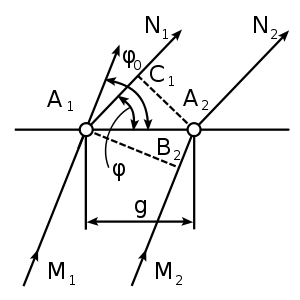Laue equations

In crystallography, the Laue equations relate the incoming waves to the outgoing waves in the process of diffraction by a crystal lattice. They are named after physicist Max von Laue (1879–1960). They reduce to Bragg's law.
The Laue equations
Let be the primitive vectors of the crystal lattice , whose atoms are located at the points that are integer linear combinations of the primitive vectors.
Let be the wavevector of the incoming (incident) beam, and let be the wavevector of the outgoing (diffracted) beam. Then the vector is called the scattering vector (also called transferred wavevector) and measures the change between the two wavevectors.
The three conditions that the scattering vector must satisfy, called the Laue equations, are the following: the numbers determined by the equations
must be integer numbers. Each choice of the integers , called Miller indices, determines a scattering vector . Hence there are infinitely many scattering vectors that satisfy the Laue equations. They form a lattice , called the reciprocal lattice of the crystal lattice. This condition allows a single incident beam to be diffracted in infinitely many directions. However, the beams that correspond to high Miller indices are very weak and can't be observed. Anyway, it is enough to find a basis of the reciprocal lattice, from which the crystal lattice can be determined. This is the principle of x-ray crystallography.
Mathematical derivation
The incident and diffracted beams are planar wave excitations
of a field that for simplicity we take as scalar, even though the main case of interest is the electromagnetic field, which is vectorial.
The two waves propagate through space independently, except at the points of the lattice, where they resonate with the oscillators, so their phase must coincide.[1] Hence for each point of the lattice we have
or equivalently, we must have
for some integer , that depends on the point . Simplifying we get
Now, it is enough to check that this condition is satisfied at the primitive vectors (which is exactly what the Laue equations say), because then for the other points we have
where is the integer .
This ensures that if the Laue equations are satisfied, then the incoming and outgoing wave have the same phase at all points of the crystal lattice, so the oscillation of the atoms, that follows the incoming wave, can at the same time generate the outgoing wave.
Relation to Bragg Law
If is the reciprocal lattice vector, we know by definition of the reciprocal lattice basis vectors that , where is an integer (we use the definition for a reciprocal lattice vector which gives the factor of ). But notice that this is nothing but the Laue equations. Hence we identify , this is sometimes called the Laue condition. In a sense, diffraction patterns are a way to experimentally measure the reciprocal lattice.
Rewriting the Laue condition:
Applying the elastic scattering condition to the above equation, we obtain:
- .
Essentially, the Laue condition is the conservation of momentum and is a consequence of the very general statement that the crystal momentum is only conserved up to a reciprocal lattice vector, while the elastic condition is the conservation of energy carried by the X-rays (i.e. the crystal gains no energy from scattering radiation).
The result is an equation for a plane (geometry). The vector specifies a set of Bragg planes in reciprocal space normal to it. Note that this implies a corresponding set of Bragg planes in real space, i.e. integer solutions for to the equation for integer coefficients and order . The vectors , , and form an isosceles triangle. This means that X-rays seemingly "reflect" off these planes at the same angle as their angle of approach (with respect to the plane).
Since the angle between and is , this implies that . Clearly, . If the lattice constant is , then ; this is because by definition we require , and moreover we can pick a set of Bragg planes in real space with interplane separation , and without loss of generality choose parallel to . With these, we now recover Bragg's law:
References
- Kittel, C. (1976). Introduction to Solid State Physics, New York: John Wiley & Sons. ISBN 0-471-49024-5
- Notes
- ↑ More realistically, the oscillators of the lattice should lag behind the incoming wave, and the outcoming wave should lag behind the oscillator. But since the lag is the same at all point of the lattice, the only effect of this correction would be global shift of phase of the outcoming wave, which we are not taking into consideration.